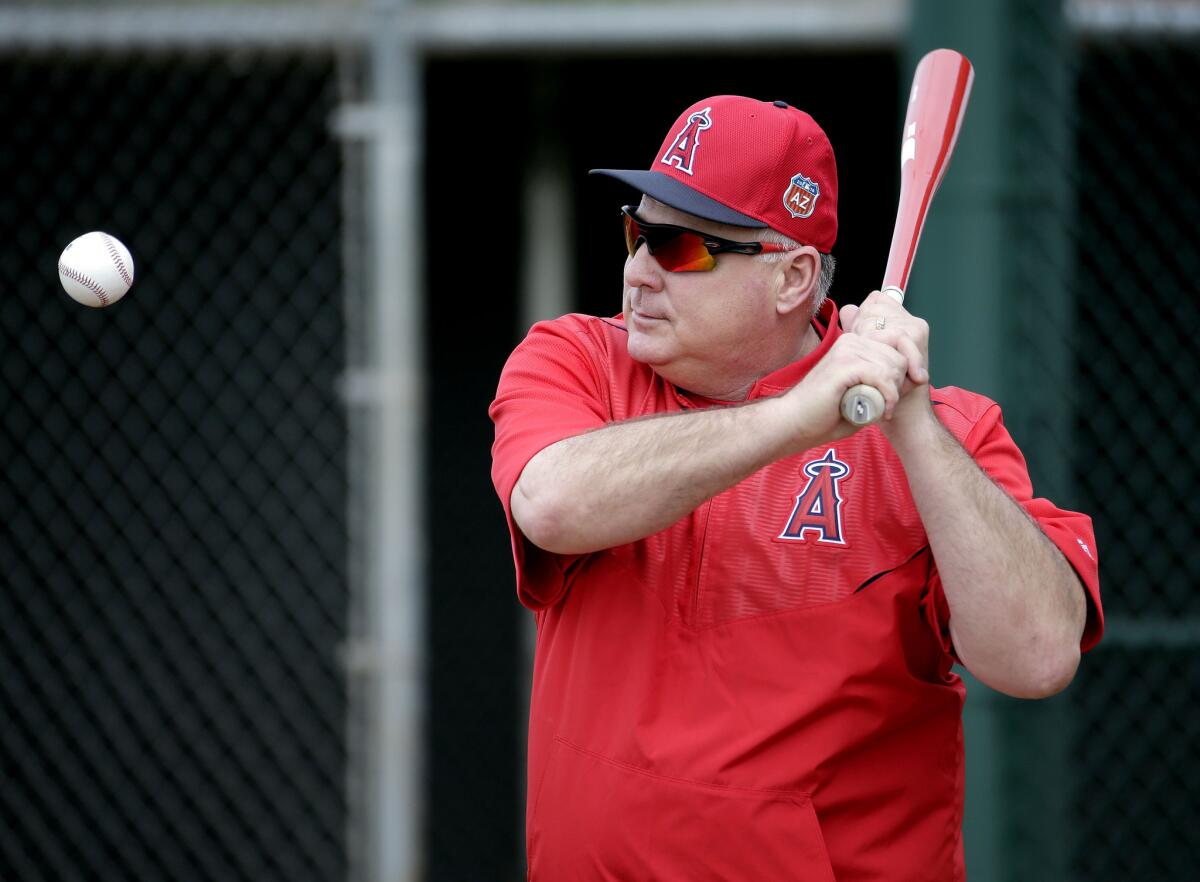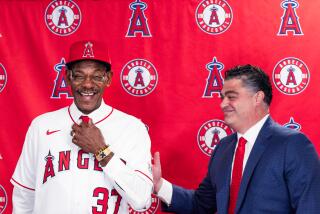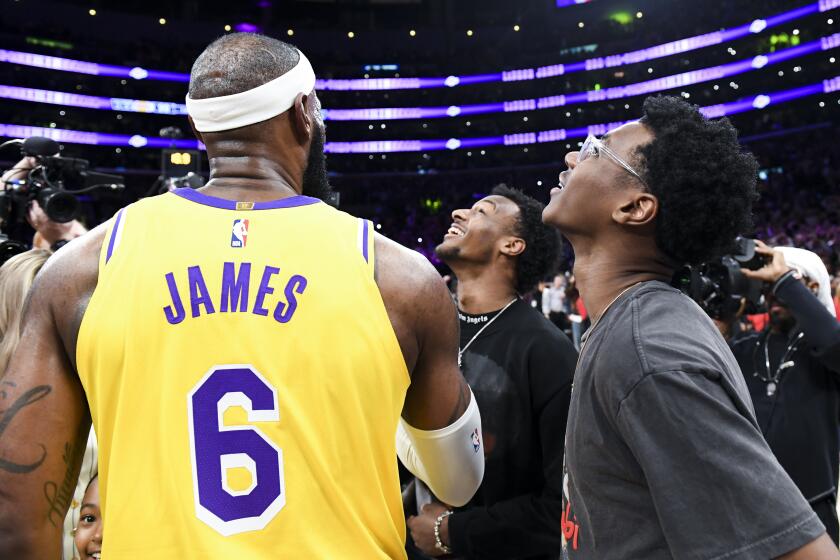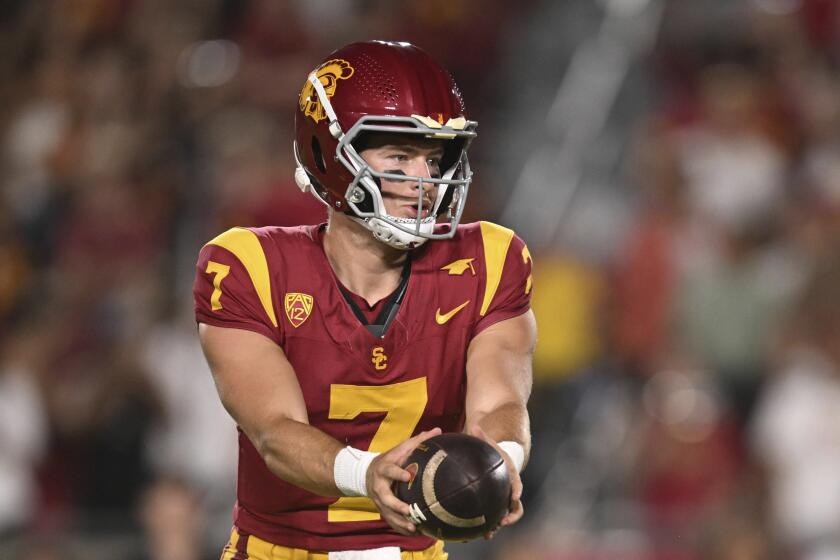Mike Scioscia says Angels incorporated analytics in previous years

Angels Manager Mike Scioscia hits to players during a spring training workout on Feb. 19.
Angels Manager Mike Scioscia thinks he has been mischaracterized.
Since Jerry Dipoto’s sudden resignation as the team’s general manager seven months ago, the national narrative surrounding Scioscia has added the account that he was unfriendly to advanced metrics during Dipoto’s tenure. He does not see it that way.
Saturday at Tempe Diablo Stadium, Scioscia was asked whether he planned to incorporate analytics in 2016 more than in previous years.
See the most-read stories in Sports this hour>>
“We incorporated everything we got in previous years,” he said.
Dipoto’s belief that Scioscia was not doing so was a primary source of the two men’s discord.
When Scioscia was then asked whether there wouldn’t be more information under new General Manager Billy Eppler’s expanded staff this year and, logically, more opportunities for incorporation, he equivocated.
“Well, if that’s your theory,” he said as the Angels continued early spring-training workouts here. “It’s going to be different. There was one set of things we looked at that we were getting from the last couple years, and this is a little different from that.”
When asked, Scioscia repeatedly declined to specify in which ways it would be different.
“I’m not going to go into detail,” he said. “I don’t think they’re proprietary, but I don’t want to tell everybody what we’re doing. But they’re interesting — very interesting.”
Scioscia said he was unsure whether the team had employed a designated analytics department in previous years. They had not, only other jobholders who spent some time working on data. He named two of those, Nick Francona and Jeremy Zoll, both of whom departed for the Dodgers over the last 14 months.
Scioscia said he didn’t know the exact size of the staff this season, only that the staffers he talked to were “freakin’ really, really bright.” Eppler has said five full-time staffers and an intern will comprise the new department, built to discover and communicate patterns in data.
Asked how the new development and streamlining of data sources could change his in-game decision-making, Scioscia said it would help him gauge his pitcher’s fatigue level. But to do that, he said, he has “always evaluated pitch-count performance and not only ERA but velocity.”
He said he has already held numerous brainstorming meetings with analytics employees, who, he acknowledged, have proposed ideas.
“The lion’s share of what analytics is going to bring is going to be for front-office use and projected performance and things like that,” Scioscia said. “As far as things in our game plan to evaluating pitchers’ effectiveness during a game, there are some really exciting things that I think we’re going to apply to help us in the decision-making process.”
The day Dipoto resigned in July, the Angels held a news conference where Scioscia said there was “nothing” to the thought that the general manager resigned because of an analytics debate. He doubled down on that Saturday.
“I’m not going to get into specifics, but I think there are different ideas that Billy has, different things that we can apply to the game,” Scioscia said. “The idea that we didn’t use analytics — I talked about it at the press conference in the summer — it’s laughable. We had scouting reports this thick with data in it that we would sift through — whether it was me, Buddy [Black], Joe [Maddon], Ron [Roenicke], all the guys — and get tendencies in a dugout that were going to help us in our decision-making process.”
After losing their managerial jobs with San Diego and Milwaukee one month apart in 2015, Black and Roenicke rejoined the Angels’ staff over the off-season. They were last on it together, alongside Maddon, in 2005. The last time any of them had worked for the Angels was 2010.
Told there have been vast new categories of information unveiled since then, Scioscia agreed. He was then asked whether he has started to incorporate the new categories.
“I’ve been incorporating those for 17 years,” he said. “I don’t know if I can make that any clearer.”
Asked whether he used analytics to manage every game the Angels played in 2015, he said he did.
“Any analytics that we got that we could apply, we did,” Scioscia said. “There were certain things, like wins above replacement, that are not applicable in a dugout. Certain things, like batting average on balls in play. I don’t want to keep going on and on… I don’t want to tell you about what we do, because I’m really excited about a lot of the things that are going on.”
Wins above replacement, or WAR, is a now-common advanced metric Fangraphs.com made public in 2008. Useful over large sample sizes, it estimates a given player’s added value over a readily available triple-A player. Dipoto cited it repeatedly in his news conference with his new team, the Seattle Mariners.
Batting average on balls in play, or BABIP, is a simpler measure, counting only how many of the balls a batter puts in play go for hits. It can be an easy red flag for luck-driven performances in short stints.
Most major league teams now make use of BABIP, WAR and dozens of other advanced metrics, primarily among the front office.
Short hops
The Angels plan to have seven former players come to camp as special guest instructors at various points this spring training. Vladimir Guerrero, Bobby Grich, Scot Shields, Buck Rodgers, Chuck Finley, Shigetoshi Hasegawa and Tim Salmon will visit. …Left-hander Tyler Skaggs, recovering from Tommy John surgery 18 months ago, said he will soon meet with the team to set a rough innings limit for him in 2016. He threw 113 MLB innings in 2014 before he ripped his elbow ligament on July 31. His career high at any level is 158 1/3 innings.
Follow Pedro Moura on Twitter @pedromoura
More to Read
Get our high school sports newsletter
Prep Rally is devoted to the SoCal high school sports experience, bringing you scores, stories and a behind-the-scenes look at what makes prep sports so popular.
You may occasionally receive promotional content from the Los Angeles Times.







